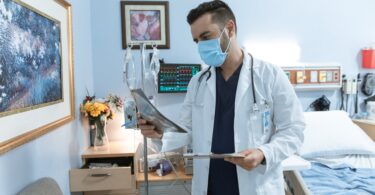
Safeguarding Your Health
In today’s world, concerns about exposure to harmful air particles and substances have become increasingly prevalent. Whether it’s in the workplace or our daily lives, the air we breathe can harbor invisible threats that pose risks to our respiratory health.
However, by understanding the importance of respiratory protection and implementing effective measures, we can take proactive steps to safeguard our well-being.
In this article, we will delve into the significance of respiratory protection and explore some key considerations to protect yourself from airborne exposures.
Understanding Airborne Exposures
Airborne exposures occur when hazardous particles or substances become suspended in the air and can be inhaled into our respiratory system.
These airborne contaminants can originate from various sources such as dust, fumes, gasses, vapors, or biological agents like bacteria or viruses.
Prolonged exposure to these substances can lead to adverse health effects, ranging from respiratory irritation and allergies to more severe conditions like lung damage or respiratory diseases.
The Role of Respiratory Protection
Respiratory protection serves as a crucial defense against airborne exposures, acting as a barrier between our respiratory system and harmful particles or substances. It plays a pivotal role in preventing inhalation of contaminants, reducing the risk of immediate or long-term health consequences.
By using appropriate respiratory protection, we can minimize the entry of airborne hazards into our lungs, ensuring a safer breathing environment.
Selecting the Right Respiratory Protection
When it comes to choosing the right respiratory protection, it’s essential to consider several factors, including the nature of the airborne hazard, the level of exposure, and the duration of exposure. Here are a few key options to explore:
Disposable Masks
Disposable masks, such as N95 or FFP2 respirators, provide a cost-effective solution for protection against solid and liquid aerosols. These masks filter out at least 95% of airborne particles, including dust, smoke, and some biological agents. However, it’s crucial to ensure a proper fit to guarantee their effectiveness.
Half-Face Respirators
Half-face respirators cover the mouth and nose, providing a higher level of protection compared to disposable masks. They are equipped with replaceable cartridges or filters designed to capture specific contaminants, such as gasses, vapors, or organic compounds. Regular maintenance and filter replacement are necessary to maintain their efficacy.
Full-Face Respirators
For more extensive airborne hazards or situations where eye protection is required, full-face respirators, including Air-Purifying respirator masks, offer comprehensive coverage. They provide a clear visor to shield the eyes while also protecting the mouth and nose. Like half-face respirators, they utilize cartridges or filters tailored to specific contaminants.
The use of an Air-Purifying respirator mask ensures that the air you breathe is effectively filtered, removing harmful particles and substances, providing an added layer of protection for your respiratory system.
Powered Air-Purifying Respirators (PAPRs)
PAPRs consist of a battery-powered blower unit that supplies filtered air to a hood or helmet worn over the head. This type of respiratory protection is suitable for environments with high concentrations of contaminants, ensuring a continuous supply of clean air. PAPRs offer a comfortable and lightweight alternative, reducing the breathing effort required compared to other options.
Implementing Effective Respiratory Protection Measures
To maximize the effectiveness of respiratory protection, it’s crucial to follow these guidelines:
Fit Testing
For tight-fitting respiratory protection, fit testing is essential to ensure a proper seal between the mask and your face. This process determines the correct size and model for each individual, optimizing protection against airborne hazards. Regular fit testing is crucial, as changes in facial features or weight may affect the seal over time.
Training and Education
Proper training and education regarding respiratory protection are paramount. Individuals should understand how to wear, inspect, and maintain their chosen respirators. They should also be aware of the limitations and restrictions associated with each type of protection.
Regular Maintenance
Maintaining and inspecting respiratory protection regularly is crucial. Replace filters, cartridges, or batteries as recommended by the manufacturer to ensure optimum performance. Clean reusable masks or respirator parts following proper procedures to remove any accumulated contaminants.
Conclusion
In a world where airborne exposures can pose significant health risks, respiratory protection is a fundamental pillar in safeguarding our well-being. By understanding the nature of airborne hazards and selecting the appropriate respiratory protection, we can breathe easier knowing we have taken active steps to protect our respiratory health. Remember, prevention is key, and investing in the right respiratory protection is an investment in your future well-being.
By prioritizing respiratory protection, we can empower ourselves to navigate the challenges of our environment while maintaining a healthy and productive life.
Stay safe, and breathe easy!






